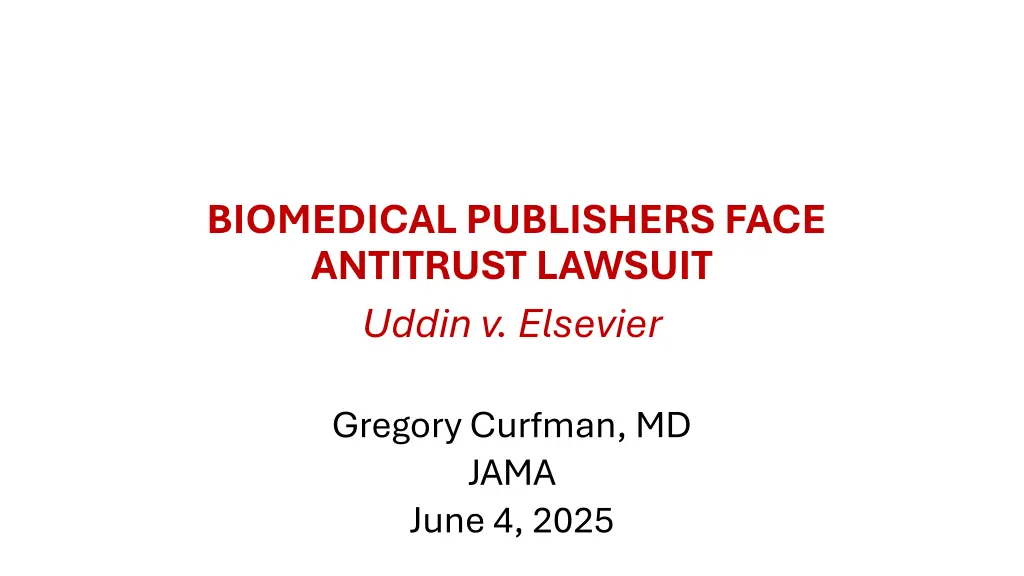
Biomedical Publishers Antitrust Lawsuit: Uddin v. Elsevier Overview
Learn about the antitrust lawsuit, Uddin v. Elsevier, where researchers challenge the single submission rule by major biomedical publishers. Explore the claims, implications, and comparisons with law journal practices.
Uploaded on | 2 Views
Download Presentation

Please find below an Image/Link to download the presentation.
The content on the website is provided AS IS for your information and personal use only. It may not be sold, licensed, or shared on other websites without obtaining consent from the author. If you encounter any issues during the download, it is possible that the publisher has removed the file from their server.
You are allowed to download the files provided on this website for personal or commercial use, subject to the condition that they are used lawfully. All files are the property of their respective owners.
The content on the website is provided AS IS for your information and personal use only. It may not be sold, licensed, or shared on other websites without obtaining consent from the author.
E N D
Presentation Transcript
BIOMEDICAL PUBLISHERS FACE ANTITRUST LAWSUIT Uddin v. Elsevier Gregory Curfman, MD JAMA June 4, 2025
DISCLOSURE The speaker serves as the executive editor of JAMA. The JAMA Network and the AMA are members of the International Association of Scientific, Technical, and Medical Publishers (STM), a trade organization that is named as one of the defendants in this lawsuit. This presentation is solely the view of the speaker and not JAMA, the JAMA Network, or the AMA.
Uddin v. Elsevier Researchers who submit and review manuscripts for the 6 largest biomedical publishers filed a lawsuit against them claiming restraint of trade in violation of Section 1 of the Sherman Act. Publishers: Elsevier, Wolters Kluwer, Springer Nature, John Wiley & Sons, Taylor and Francis, Sage Publications (and the STM Trade Organization) The case was filed in the U.S. District Court for the Eastern District of New York (Brooklyn). Judge Hector Gonzalez
Uddin v. Elsevier The Claims Plaintiffs complaint alleges 3 claims: Publishers collude to set reviewer payment to $0. Publishers require manuscripts to be submitted only to one journal at a time (single submission rule). Publishers require that manuscripts not be distributed while under peer review. This presentation focuses on the second claim, the single submission rule.
The Single Submission Rule Biomedical journals require that manuscripts be submitted to one journal at a time. Publishers and editors contend that duplicate (or more) submissions are unethical. Plaintiffs argue that this ad seriatim policy is anticompetitive. They further argue that the policy delays the publication process, which is not in the best interests of either patients or researchers. Journals with the highest impact factors will have first choice of top articles.
Biomedical Journals versus Law Journals In contrast to biomedical journals, law review journals permit multiple simultaneous submissions. In fact, this is standard practice. Law journals interested in a particular manuscript compete to acquire the manuscript. If multiple simultaneous submissions are not considered unethical for law journals, why are they unethical for biomedical journals? This appears to be a contradiction. Some legal scholars criticize the multiple submission policy of law journals, but this practice has stood the test of time.
Uddin v. Elsevier The Antitrust Analysis Restraint of trade analysis may proceed along 3 tracks: Per se violation Rule of reason Quick look If this case reaches the merits, it will likely be decided by the rule of reason, based on burden shifting and the consumer welfare standard. Plaintiffs must demonstrate an anticompetitive effect. Defendants must counter and show that there are procompetitive justifications. Plaintiffs: Less restrictive alternative The court may apply a balancing test.
Motion to Dismiss The defendants motion to dismiss was filed on May 5. The motion states, in summary, that there is no evidence of collusion among the publishers. The motion further states that there is no evidence provided by plaintiffs of an anticompetitive outcome and therefore there is no Sherman violation. The plaintiffs response to the motion to dismiss is due in July.
Implications If the case reaches the merits and the plaintiffs prevail, there will be significant consequences for biomedical journals, editors, and publishers. Reviewers will have to be compensated. Authors will be free to disseminate their research while peer review is in progress (including dissemination to the media). Manuscripts may be submitted to more than one journal simultaneously, and biomedical journals will then operate more like law review journals.
Final Words In my opinion, the greatest impact of such an outcome will be the overthrow of the single submission rule. Biomedical journals will need to compete with one other for acquisition of manuscripts. The publication process may consequently become faster and more efficient. Will the quality of the peer review process suffer as a result of greater speed? A similar process seems to work well for law review journals, so why not for biomedical journals?






















